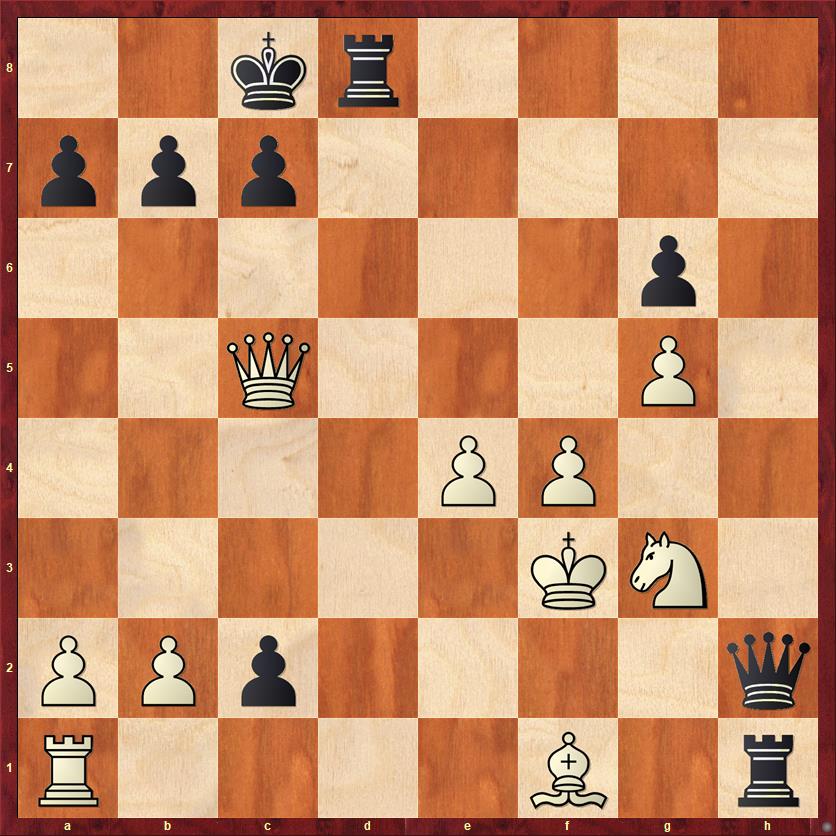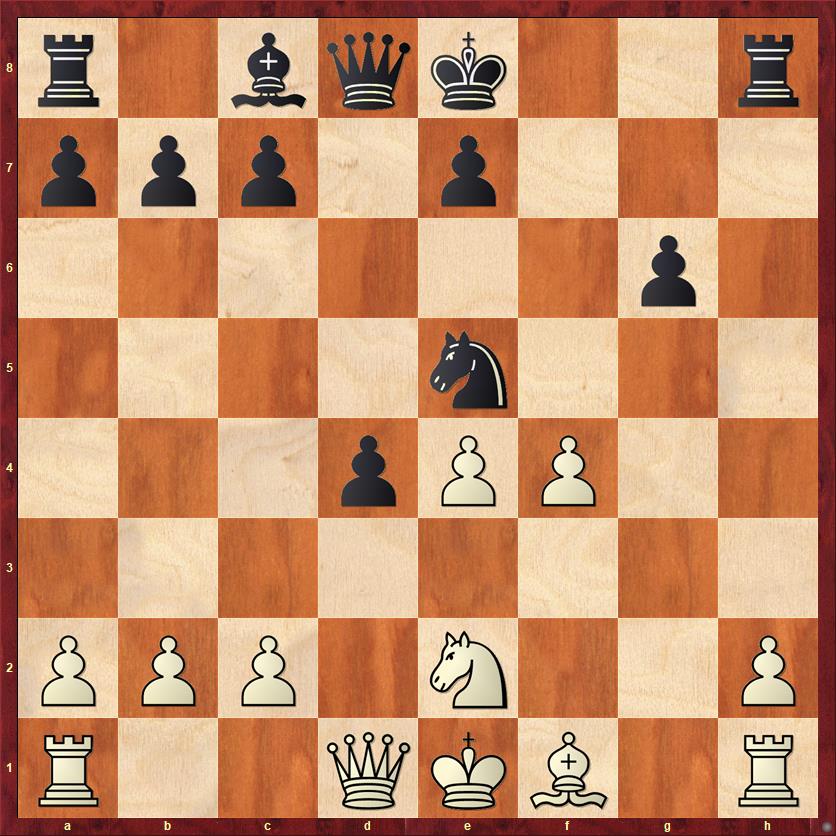Just when I think I’m wasting my time playing so many games against the computer, along comes a game like this one! I’ll show you the end first.

FEN: 2kr4/ppp5/6p1/2Q3P1/4PP2/5KN1/PPp4q/R4B1r b – – 0 23
I’m playing Black against Fritz, with its rating set at 2025. What would you do? If you want a little bit more pressure, imagine you have 200 seconds (3:20) left on your clock to make 18 moves.
Here’s the move I played, which was good enough to draw but not good enough to win:
23. … Rd1 24. Qf8+ Kd7 25. Qf7+ Kd8 1/2 – 1/2 (actually a threefold repetition occurred a few moves later but we’ll skip the details).
But there’s a better move than 23. … Rd1. Have you found it yet? Most importantly, have you found the followup?
After the game I was able to figure it out, but only because I had the huge clue that Fritz was evaluating this position at +14 pawns for Black. Without that clue, I was not able to find the winning line. I’m not sure I could have found it even in a full-length tournament game.
The starting move is one that certainly should be on your candidate-move list:
23. … Rxf1+!!
Of course, we all see the super-cool checkmate after 24. Nxf1 Rd3+ 26. Kg4? Qh5 mate. But the real question is what to do after
24. Nxf1 Rd3+ 25. Ne3!
This is what stopped me. It looks as if I have sacrificed an exchange just to put my opponents’ pieces in a better position. None of the checks seem to get anywhere.
So here’s where it helps to know that Black is supposed to be winning. If the checks don’t work, we have to start looking at non-checks. If I don’t check, then I need to do something to avoid a perpetual check from White’s queen.
I’ve given you all the clues you need: 1) The correct move is not a check. 2) The correct move should give my king an escape from queen checks. 3) The correct move should make a threat of some kind. What is it?
Answer: 25. … b6!!
An amazing move that does everything: it makes luft for my king and it attacks the queen, which has no way to maintain its defense of the knight on e3. Black wins! If I had seen this combination, I would be walking on cloud nine. It’s the hardest thing to do in chess — sacrifice material and then play a quiet prophylactic move.
So that’s the lesson for today. When the bombs are going off and the bullets are whizzing all around you, sometimes it’s a quiet little move that decides the battle.
Now let me show you how the game got to this point, because that was highly entertaining, too.
Fritz 17 (2025) — Dana, 40 moves/10 minutes
1. d4 Nf6 2. Nc3 d5 3. Bf4 Nh5!?
Longtime readers might remember that I prepared this variation to play against Paulo Santanna in the last round of the 2019 Kolty Chess Club Championship. That game continued 4. Bg5 h6 5. Bh4 Nf6!? I eventually won the game, tied for first in the club championship and won the title on tiebreaks. Fritz 17 plays a much more drastic variation that tries for an outright refutation but fails.
4. Be5 f6 5. e4 g6 6. g4!? …
Creating absolute chaos on the board. Ordinarily, chaos is good for a computer, because they can find their way in random positions much better than humans can. But I’ve played this position a few times now against Fritz, and I know that Black is okay.
6. … fe 7. gh Bg7! 8. de d4 9. Nce2 Bxe5 10. hg hg 11. Nf3 …
The main alternative seems to be 11. f4 Bg7 12. Nf3 Bg4, but Black is doing fine there as well.
11. … Nc6! 12. Nxe5 Nxe5 13. f4?! …
First of all, notice that 13. Nxd4? loses a piece because of 13. … Qxd4! 14. Qxd4 Nf3+ forking the king and queen. Also no good are 13. Bg2? d3! or 13. Nf4? Rh4! or 13. Ng3? Bg4 14. Be2 Bxe2 15. Qxe2 d3. So even though the move White played looks absolutely reckless, it’s really his only hope.
Time for a diagram.

FEN: 2kr4/ppp5/6p1/2Q3P1/4PP2/5KN1/PPp4q/R4B1r b – – 0 23
In this position Fritz has a slight preference for 13. … Nc6 (+0.18 for Black). Perhaps I will play that in the future, knowing that the game continuation is only good enough for a draw. But I didn’t know that, and I was in the mood for battle.
13. … Nf3+!?
The thing I’m proudest of in this game is that from here until move 23 I played perfectly, according to Fritz. But it’s disappointing that perfect play leads only to a draw.
14. Kf2 Bg4 15. h3 e5!
Inviting all of my pieces to the party. 15. … Bh5 16. Ng3 Nh4 17. Nxh5 Rxh5 is playable but not as fun.
16. hg Rxh1 17. Kxf3 Qh4
An alternative is 17. … Qf6 but Fritz evaluates that as equal, too.
18. Qe1 Qh6! 19. Qa5 O-O-O!
I frankly had no idea what was going on here. I didn’t even know whether it was better for White to take the a-pawn or the e-pawn. But I knew that I needed to get my rook into the attack, so the decision to castle was easy.
20. Qxe5 …
In fact 20. Qxa7? would lose to 20. … Rf8! Note that the queen is guarding the rook — a key point, and a reason why 18. … Qh6 was a good move. Sometimes things just work out right.
20. … d3!
Of course. There’s no turning back now. Black must attack with maximum vigor.
21. Ng3 dc! 22. g5 …
Here or on the next move White could bail out to a draw with 22. Nxh1 Qxh1+ 23. Kg3 Qg1+ 24. Kf3. If he tries to make a break for it with 24. Kh4 instead, Fritz says that it’s still equal after 24. … Qh1+ 25. Kg5 Rh8.
22. … Qh2 23. Qc5? …
This gets us to the position we began the post with. As noted above, 23. Nxh1 would still be good enough to draw for White, but the computer evidently wanted to give me a sporting chance to win.
It’s funny that I played 3. … Nh5 to avoid the Jobava variation, but in the end we played a game that was as wild and woolly (and weird and wonderful) as anything Jobava ever played. The difference, though, is that here it was Black calling the shots, but in the Jobava variation it’s usually White. Whether you’re playing against a computer or a grandmaster, you definitely have a better chance if you’re the one with the initiative.
Ironically, this was my fifth consecutive draw against Fritz. Just a weird coincidence, really; none of the five games were “boring draws,” this one especially.
Finally, let me mention that because of my computer issues with the blog’s comment function not working properly, I will manually cut-and-paste any comments into this post. I have already done that with my previous post (“A Notorious Endgame,”) which received comments from Larry Smith and Ernest Hong.



{ 2 comments… read them below or add one }
Dear Dana,
in your first game (Dana against Shredder) is a typo. It should be 17. Qh4+ and not 16. Qh4+
Best regards
Lutz
Thanks! This comment actually refers to the post after this one, but I made the corrections there.